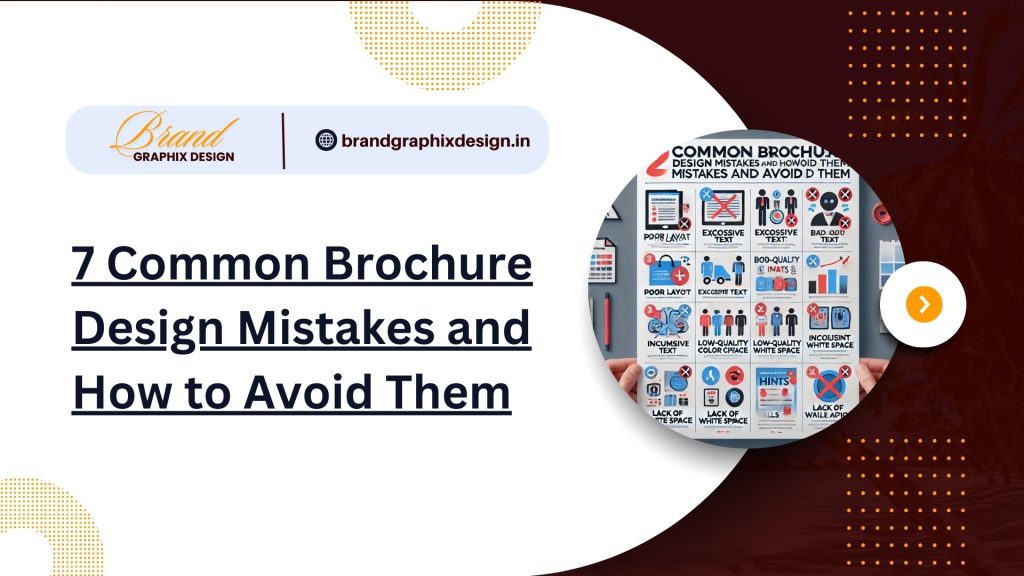Introduction: Why a Well-Designed Brochure Matters
In today’s competitive market, brochures are still an important tool to showcase your business, products, or services. They offer a tangible way for potential customers to know about your brand. But designing an effective brochure requires more than just attractive visuals and content. Small mistakes can turn a good design into an ineffective one. To help you get the most out of your brochures, here are seven common brochure design mistakes you must avoid and tips on how to avoid them.
1. Overloading the Brochure with Too Much Information
One of the most common mistakes in brochure design is trying to include too much information. Your audience doesn’t want to read long paragraphs of text. A cluttered design with excessive content can confuse and overwhelm readers, making them lose interest quickly.
- Keep your content simple and to the point.
- Use bullet points and short paragraphs for easy reading.
- Highlight the key points of your product or service.
Remember, the purpose of a brochure is to create interest and prompt the reader to take action, not to give every detail about your business in one go.
2. Ignoring the Target Audience
A brochure should always be designed with the target audience in mind. Ignoring this important step can result in a brochure that doesn’t connect with the readers. If your brochure doesn’t appeal to your intended audience, all your efforts may go to waste.
- Identify your audience and tailor the design and content to their preferences.
- Use language that resonates with your target demographic.
- Consider factors such as age, location, and needs when designing your brochure.
By focusing on your target audience, you can create a brochure that speaks directly to their interests and encourages them to engage with your brand.
3. Poor Quality Images
Low-resolution or irrelevant images can ruin the overall appearance of your brochure. Poor quality images not only affect the visual appeal but also give a bad impression of your brand. The quality of images plays a crucial role in how your brochure is perceived.
- Use high-resolution images that are clear and professional.
- Avoid using stock images that don’t match your brand’s message.
- Ensure that the images align with the content and reinforce your brand.
High-quality images make your brochure look more polished and professional, which helps to build trust with your audience.
4. Lack of a Clear Call to Action (CTA)
A well-designed brochure should encourage the reader to take some kind of action, whether it’s calling your business, visiting your website, or following you on social media. Failing to include a clear call to action is a huge mistake that can reduce the effectiveness of your brochure.
- Always include a clear and compelling CTA.
- Make it easy for the reader to understand what they should do next.
- Use action-oriented words like “Call Now,” “Visit Us,” or “Get a Free Quote.”
Your call to action should stand out visually and be easy to find within the brochure layout.
5. Inconsistent Branding
Brand consistency is important for building trust and recognition. If your brochure doesn’t align with the rest of your brand’s visual elements, it can confuse your audience and dilute your brand message.
- Ensure that the colors, fonts, and logo match your brand guidelines.
- Maintain consistency in the tone of your content.
- Use a design that reflects your brand’s personality and values.
Consistency helps to create a professional and cohesive look, making your brochure more effective in communicating your brand’s message.
6. Not Paying Attention to Typography
Typography plays a huge role in the readability and visual appeal of your brochure. Using too many different fonts, incorrect font sizes, or hard-to-read fonts can make your brochure look unprofessional and confusing.
- Stick to one or two fonts for a clean, organized look.
- Ensure that the font size is readable, especially for important information.
- Avoid using decorative fonts that are hard to read.
Good typography ensures that your message is clear and easy to read, which improves the overall impact of your brochure.
7. Skipping the Proofreading Process
One of the simplest but often overlooked steps in brochure design is proofreading. Typos, grammatical errors, and incorrect information can make your business look unprofessional and careless. Even small errors can have a negative effect on how potential customers perceive your brand.
- Always proofread your content before sending it to print.
- Get a second pair of eyes to review the brochure for errors.
- Ensure that all contact details, pricing, and other information are correct.
A thorough proofreading process helps avoid costly reprints and ensures that your brochure sends the right message to your audience.
How to Avoid These Common Mistakes
To avoid these common brochure design mistakes, it’s important to plan ahead and consider every element of your design. Here are a few general tips to ensure your brochure is effective:
- Focus on the purpose of the brochure and stick to it.
- Work with a professional designer who understands your brand.
- Test your brochure with a small audience before finalizing the design.
By following these tips and avoiding common mistakes, you can create a brochure that not only looks great but also effectively promotes your business.
Ready to Create the Perfect Brochure?
Don’t let common mistakes ruin your brochure design. If you need help designing a brochure that stands out and delivers results, contact us today at +91 91189 11171. Our team of professional designers will work with you to create a brochure that reflects your brand and captures your audience’s attention. WhatsApp us now to get started!


